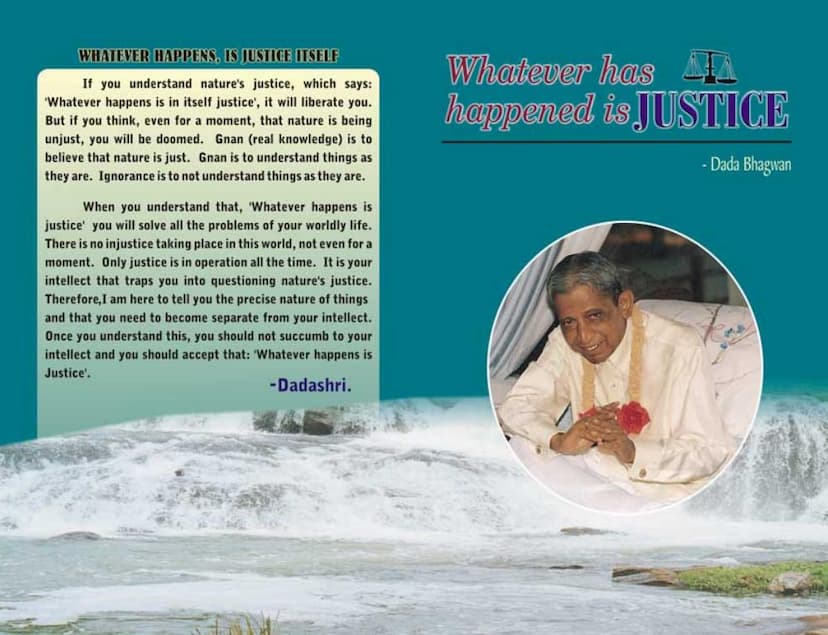Whatever Has Happened Is Justice
Added to library: September 2, 2025

Summary
This document, "Whatever Has Happened Is Justice" by Dada Bhagwan, published by Dada Bhagwan Foundation, presents a profound spiritual philosophy centered on the concept of absolute natural justice. The core message is that everything that occurs, has occurred, or will occur is inherently just, according to the precise laws of nature.
Here's a comprehensive summary of the key themes and arguments presented:
1. The Nature of Natural Justice:
- Absolute and Unwavering: The central tenet is that nature operates with perfect and unwavering justice. There is never a moment of injustice, unlike human laws which can be flawed.
- Cause and Effect: Natural justice is understood as the direct result of past actions and karmas. Whatever one experiences is a precise settlement of outstanding accounts from previous lives.
- Vyavasthit (Scientific Circumstantial Evidence): This term is used to describe the intricate web of causes and circumstances that nature orchestrates to bring about events. Nothing happens randomly or without a cause.
- Not Personal or Emotional: Nature is not a person or a God with personal biases. It is a scientific, impersonal force that operates through precise laws.
2. The Role of the Intellect and the Pursuit of Justice:
- The Intellect's Illusion: The human intellect, driven by its limited perspective and ego, is the primary source of the perception of injustice. It constantly questions and seeks worldly justice, leading to misery and confusion.
- "Whatever Happens Is Justice" as Liberation: Understanding and accepting this fundamental principle is presented as the key to liberation from suffering and worldly problems. It leads to inner peace and harmony.
- Separation from Intellect: The teachings advocate for becoming detached from the intellect and its incessant questioning of justice.
- The "Fault is of the Sufferer": This related principle suggests that the individual experiencing suffering is the one who has created the causes for it through their own past actions.
3. Examples and Illustrations:
The text uses numerous examples to illustrate the principle of natural justice:
- Avalanches and Natural Disasters: Deaths in avalanches are seen as the precise moment for those individuals whose karmic accounts were due for such an event. Earthquakes, hurricanes, and floods are also natural justice in operation.
- Inheritance Disputes: Unequal distribution of inherited property is explained as each individual receiving precisely what they were destined to receive based on past karmic accounts.
- Theft and Loss: Losing a wallet or a watch is attributed to outstanding karmic debts. The precise manner in which a lost item might be recovered is also presented as evidence of nature's exactness.
- Murderers and Criminals: A murderer being found innocent in a human court is attributed to the punya (merit) from past lives, while the victim is considered to have had a pending account with the murderer. The world needs "snakes and thieves" as instruments for settling these accounts.
- Interpersonal Conflicts: When someone hurts you, it is seen as a settlement of a past account. Even harsh criticism or unfair treatment is viewed as justice.
- Financial Transactions: A shopkeeper giving incorrect change is explained as nature settling accounts based on past karma.
4. The Path to Liberation (Akram Vignan):
- The Gnani Purush: The teachings are attributed to "Gnani Purush" Ambalal Muljibhai Patel, known as Dadashri or Dada Bhagwan, who experienced spontaneous Self-realization. He is presented as a living example of this principle.
- Akram Vignan (Step-less Science): This is a direct and easy path to Self-realization, imparted by Dada Bhagwan through a scientific process called Gnan Vidhi. It simplifies spiritual progress.
- The Role of Dada Bhagwan (The Lord Within): Dada Bhagwan is explained as the fully manifested Lord within, which is also present in everyone else, though not fully manifested.
- Focus on Experience, Not Theory: The teachings emphasize practical application of this knowledge in daily life rather than theoretical understanding.
- Eliminating Questions: By accepting that "Whatever happens is justice," all questions cease, and this leads to liberation and freedom from suffering.
5. Practical Application:
- Observe, Don't Question: Instead of questioning why things happen, one should simply observe and accept them as justice.
- Acceptance and Non-Resistance: In difficult situations, the advice is to accept them as justice and avoid creating further complications through intellectual arguments or legal battles.
- Focus on Internal Change: The aim is to bring about an inner shift in perception rather than trying to change external circumstances.
- Humility and "I Don't Know Anything": Ultimate humility and an awareness of one's own limitations are presented as pathways to universal oneness.
In essence, "Whatever Has Happened Is Justice" is a radical reorientation of perspective, urging individuals to transcend the limitations of their intellect and ego by recognizing the inherent justice in all events. This acceptance, the book argues, is the direct path to freedom from suffering and a peaceful, harmonious life.